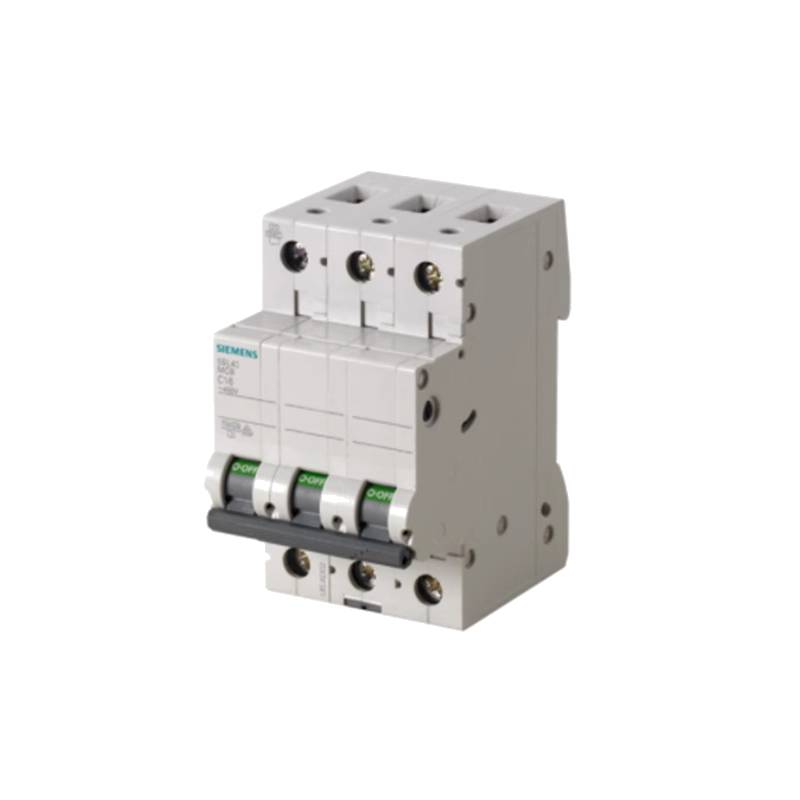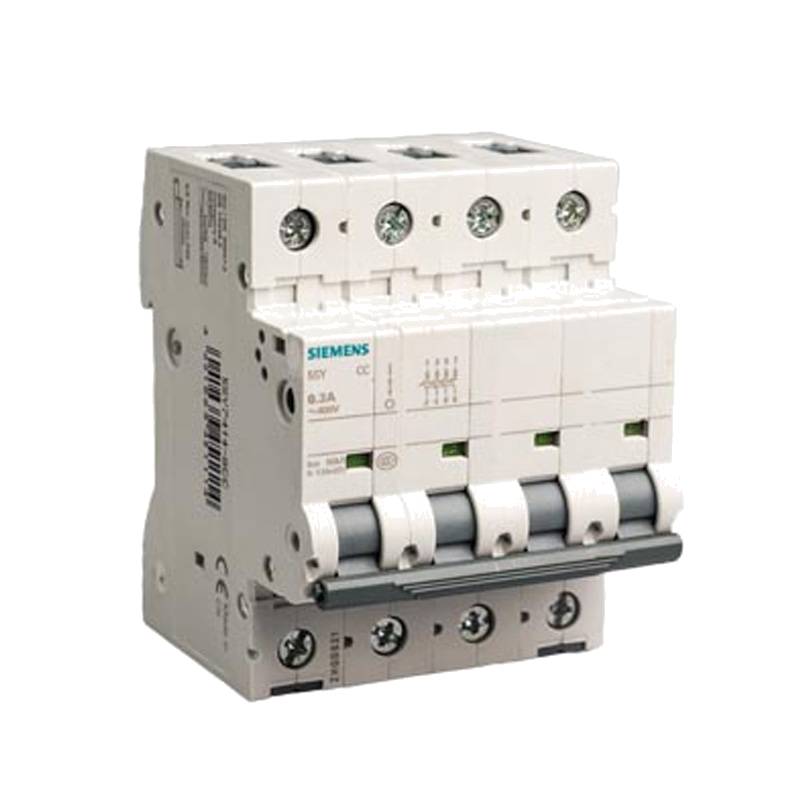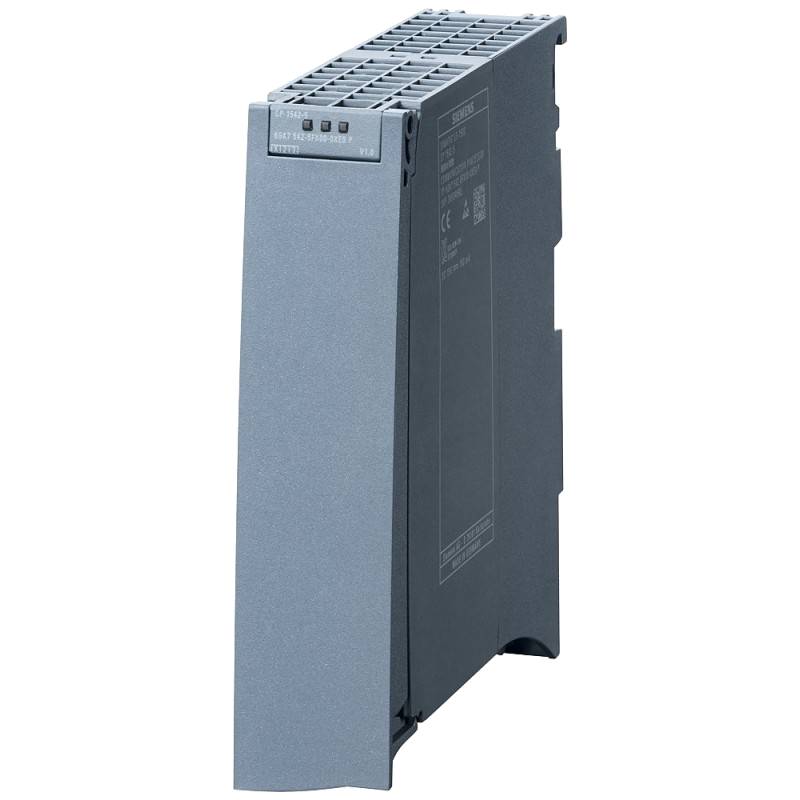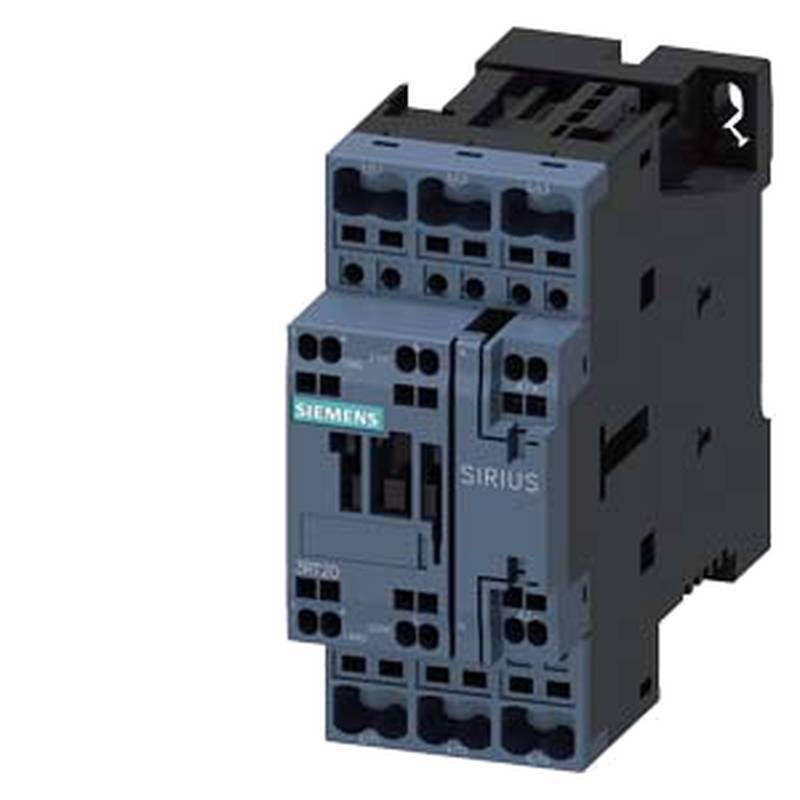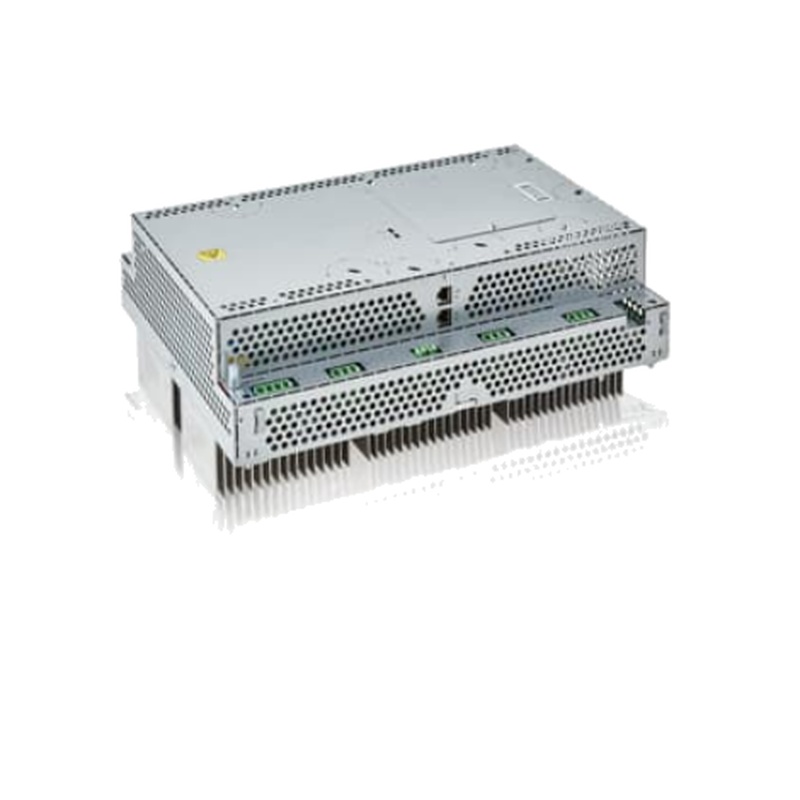
The Siemens 5SN6320-8CN is a robust 3-pole, 20-amp Miniature Circuit Breaker (MCB) engineered for industrial applications demanding high breaking capacity and reliable circuit protection. This MCB offers superior fault current interruption, ensuring operational safety and equipment longevity in demanding electrical environments. Its core advantages lie in its industrial-grade construction, advanced tripping mechanisms, and seamless integration into complex power distribution systems, making it a cornerstone for safeguarding critical machinery and processes.
Product Specifications
| Feature | Specification |
| :----------------------- | :--------------------------------- |
| Product Type | Miniature Circuit Breaker (MCB) |
| Manufacturer | Siemens |
| Model Number | 5SN6320-8CN |
| Number of Poles | 3 |
| Rated Current | 20A |
| Breaking Capacity (Icu) | 10kA (IEC 60947-2) |
| Tripping Characteristic | Type C |
| Voltage Rating | 400V AC |
| Frequency | 50/60 Hz |
| Mounting Type | DIN Rail |
| Operating Temperature | -25°C to +55°C |
| Terminal Type | Screw Terminal |
| IP Protection Rating | IP20 (Enclosure) |
Core Features & Market Positioning
The Siemens 5SN6320-8CN distinguishes itself in the industrial protection market through its high breaking capacity of 10kA, significantly exceeding standard residential MCBs. This robust performance is crucial for applications where short-circuit currents can reach dangerous levels, preventing catastrophic failures and ensuring personnel safety. The Type C tripping characteristic provides enhanced protection against inductive loads, common in industrial settings, offering a balance between preventing nuisance tripping and safeguarding against overload and short circuits. Its industrial-grade design signifies durability and reliability under continuous, demanding operational cycles. Siemens' reputation for quality engineering further solidifies the 5SN6320-8CN's position as a trusted solution for critical power distribution.
Key Application Scenarios
This 3-pole, 20A MCB is ideally suited for protecting main power feeds and branch circuits in various industrial sectors. It excels in safeguarding motor control centers, pump systems, conveyor belts, and HVAC equipment, where inductive loads and potential fault currents are prevalent. Its application extends to manufacturing plants, processing facilities, and commercial buildings requiring reliable power distribution and protection for three-phase equipment. The 10kA breaking capacity is particularly vital in areas with higher fault current potential, such as near transformers or in facilities with extensive electrical networks.
Practical System Integration Guidance
Integrating the Siemens 5SN6320-8CN into existing industrial electrical systems is straightforward due to its standard DIN rail mounting. Ensure proper torque is applied to the screw terminals during wiring to establish secure connections, preventing overheating and ensuring optimal conductivity. For 3-phase applications, connect the incoming power lines to terminals L1, L2, and L3, and outgoing protected circuits to the corresponding lower terminals. Always verify the system's rated voltage and current against the MCB's specifications before installation. Safety protocols, including de-energizing the circuit and using appropriate personal protective equipment (PPE), must be strictly followed during any installation or maintenance activity.
Operation and Risk Mitigation
The Siemens 5SN6320-8CN operates by detecting overcurrents (overloads and short circuits) and interrupting the electrical circuit to prevent damage to connected equipment and wiring, as well as to mitigate fire hazards. The thermal element within the MCB responds to sustained overloads, while the magnetic element reacts instantaneously to high short-circuit currents. Understanding its Type C tripping curve is essential; it typically trips between 5 to 10 times the rated current, which is suitable for equipment with moderate inrush currents. To mitigate risks, regular visual inspections for any signs of damage or overheating are recommended. In the event of frequent tripping, a thorough investigation of the load and potential fault conditions is imperative, rather than simply upsizing the MCB, which could compromise protection.
Scalability & Long-Term Value
The Siemens 5SN6320-8CN offers excellent long-term value through its robust construction and compatibility with broader Siemens industrial control and automation platforms. While MCBs themselves are primarily protection devices and not directly "scalable" in terms of increasing their own rating, their integration into a well-designed electrical distribution system allows for straightforward expansion of circuits. The 5SN6320-8CN can be part of a system that is planned for future growth, allowing additional, appropriately rated circuits to be added adjacent to it on the same busbar. Its adherence to international standards ensures it remains a viable component in evolving electrical infrastructure, including potential future integration with smart grid technologies or IIoT monitoring systems through compatible ancillary devices.
Frequently Asked Questions
What is the breaking capacity of the Siemens 5SN6320-8CN?
The Siemens 5SN6320-8CN boasts a breaking capacity of 10kA. This means it can safely interrupt fault currents up to 10,000 Amperes. This high rating is critical for industrial environments where fault currents can be substantial.
This high breaking capacity ensures it can effectively protect circuits from severe short circuits. It significantly reduces the risk of catastrophic equipment damage and electrical fires. Such a rating is essential for compliance with stringent industrial safety standards.
The 10kA rating provides a robust safety margin. It is suitable for applications where the source impedance might be low, leading to higher potential fault currents. This makes it a reliable choice for main distribution boards or circuits close to power sources.
What type of tripping characteristic does the 5SN6320-8CN have?
This Siemens MCB features a Type C tripping characteristic. This characteristic is designed for circuits with moderate inrush currents, such as those associated with inductive loads. It generally trips between 5 to 10 times its rated current.
Type C MCBs are commonly used for lighting and power circuits in industrial and commercial settings. They offer a good balance, preventing nuisance tripping from temporary surges but still providing adequate protection against overloads and short circuits. This makes it suitable for motor circuits.
Compared to Type B, Type C MCBs are less sensitive to sudden current spikes. Compared to Type D, they are more sensitive to smaller overloads. The selection of Type C ensures optimal protection for many typical industrial applications.
Can the Siemens 5SN6320-8CN be used for DC applications?
The Siemens 5SN6320-8CN is primarily designed and rated for AC applications. While some MCBs can be adapted for DC use under specific conditions, this model's specifications indicate it is intended for 400V AC systems. Using it for DC without specific DC rating information can be unsafe.
For DC circuits, different tripping mechanisms and insulation properties are required. Attempting to use an AC-rated MCB on a DC circuit can lead to arc-restriking issues and unsafe operation. It's crucial to consult the manufacturer's data for DC suitability.
Always refer to the product datasheet or contact Siemens technical support for confirmation on DC application use. Employing the correct type of circuit breaker designed for the specific voltage and current type (AC or DC) is paramount for safety and reliability.
What is the rated current and voltage for this MCB?
The Siemens 5SN6320-8CN has a rated current of 20 Amperes. It is designed for a nominal voltage of 400V AC. This combination makes it suitable for many standard industrial branch circuits.
This 20A rating means it can safely handle continuous loads up to 20A. The 400V rating specifies the maximum voltage it is designed to operate within safely. Exceeding these ratings can lead to premature failure or hazardous conditions.
When selecting an MCB, it's vital to match the circuit's expected load and voltage to the breaker's specifications. Using a 20A, 400V AC MCB ensures it is correctly sized for the application, providing effective protection without being overly restrictive.
How do I install the Siemens 5SN6320-8CN MCB?
Installation involves mounting the MCB onto a standard 35mm DIN rail. Ensure the circuit is de-energized before commencing any work. Connect the incoming power to the top terminals and the outgoing load to the bottom terminals.
For 3-pole applications, connect the three phases sequentially to L1, L2, and L3 at the top and corresponding outputs at the bottom. Use appropriate torque settings for the screw terminals to ensure a secure and reliable electrical connection. Always follow local electrical codes and safety guidelines.
It is recommended that installation be performed by a qualified electrician. Proper wiring, grounding, and adherence to torque specifications are critical for the safe and effective operation of the MCB and the entire electrical system.
What does "3P" signify for this MCB?
"3P" stands for three-pole. This indicates that the circuit breaker is designed to interrupt all three phases of a three-phase electrical supply simultaneously. It is used for protecting three-phase loads.
By interrupting all three poles, it ensures that no single phase remains energized when a fault occurs. This is crucial for protecting three-phase motors and other equipment from single-phasing damage, which can lead to overheating and failure. It provides comprehensive circuit protection.
The three-pole configuration is standard for industrial applications involving three-phase power distribution. It ensures that the circuit is completely disconnected from the power source, enhancing safety and preventing potential damage to connected machinery.
What are the typical applications for a 20A, 3-pole MCB?
A 20A, 3-pole MCB like the 5SN6320-8CN is commonly used for protecting three-phase motors. Applications include pumps, fans, compressors, and small industrial machinery operating on a 3-phase supply. It is also suitable for branch circuits in industrial power distribution panels.
Its 20A rating is appropriate for loads drawing up to this current under normal operating conditions. The 3-pole design ensures simultaneous disconnection of all phases, protecting against unbalanced loads and single-phasing conditions common with motor loads.
These breakers are essential components in motor control centers (MCCs) and distribution boards within manufacturing plants, workshops, and other industrial facilities. They provide reliable overcurrent and short-circuit protection for essential equipment.
What is the significance of the "8CN" in the model number?
The "8CN" is part of Siemens' internal product coding for this specific MCB variant. It helps to identify its exact specifications, such as tripping curve, breaking capacity, and other subtle features within the broader Siemens product catalog. It is not a universally understood technical parameter but a manufacturer-specific identifier.
Understanding these codes is crucial for ordering the correct replacement parts or ensuring compatibility within a Siemens system. It distinguishes this particular 20A, 3P, 10kA MCB from other similar breakers offered by Siemens with different characteristics or ratings.
For precise technical details beyond the core specifications, referring to the "8CN" designation in Siemens documentation or datasheets is necessary. It ensures that the specified part matches the exact requirements of the electrical installation.
Does this MCB require any auxiliary contacts or accessories?
The Siemens 5SN6320-8CN can optionally be fitted with auxiliary contacts or alarm contacts. These accessories allow for remote signaling of the MCB's status (e.g., tripped or ON/OFF) to a control system or SCADA. Additional accessories like shunt releases can also be added for remote tripping.
Auxiliary contacts (often denoted as SAK or Vario) provide status feedback, useful for automation and monitoring. Alarm contacts (often denoted as MF or OM) signal a fault condition, such as a trip event, allowing for automated response or alerts. Shunt releases enable remote electrical tripping.
While not strictly required for basic protection, these accessories enhance the functionality and integration of the MCB into more sophisticated electrical management systems. They are particularly valuable in large industrial plants for comprehensive system monitoring and control.
What is the environmental operating range for this circuit breaker?
This industrial-grade MCB is designed to operate within a temperature range of -25°C to +55°C. This wide range ensures reliable performance in various industrial environments, from cold storage facilities to hot processing areas. It meets stringent industrial operating condition requirements.
The temperature limits are critical for maintaining the accuracy and reliability of the tripping mechanisms. Operating outside these specified limits can affect the MCB's performance, potentially leading to nuisance tripping or failure to trip when required.
Adhering to these environmental specifications is part of safe and effective installation. It ensures that the Siemens 5SN6320-8CN will perform as intended under typical industrial ambient conditions, providing consistent protection.














